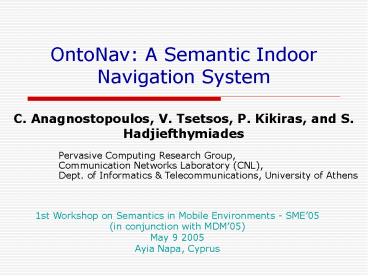OntoNav: A Semantic Indoor Navigation System - PowerPoint PPT Presentation
1 / 19
Title:
OntoNav: A Semantic Indoor Navigation System
Description:
Communication Networks Laboratory (CNL), Dept. of Informatics & Telecommunications, University of Athens ... Racer OWL reasoning engine. PostGIS spatial database ... – PowerPoint PPT presentation
Number of Views:341
Avg rating:3.0/5.0
Title: OntoNav: A Semantic Indoor Navigation System
1
OntoNav A Semantic Indoor Navigation System
C. Anagnostopoulos, V. Tsetsos, P. Kikiras, and
S. Hadjiefthymiades
- Pervasive Computing Research Group,
- Communication Networks Laboratory (CNL),
- Dept. of Informatics Telecommunications,
University of Athens
1st Workshop on Semantics in Mobile Environments
- SME05 (in conjunction with MDM05) May 9 2005
Ayia Napa, Cyprus
2
Presentation Structure
- Introduction
- System Design
- Conclusions
3
Indoor Location Based Services
- Traditional LBS
- Navigation, find nearest POIs, etc.
- Based on geometric location modeling
- Semantic LBS
- Intelligent service provisioning based on
ontological knowledge representation and hybrid
location modeling - Human-centered services, suitable for people with
disabilities - Can be deployed to pervasive environments
4
Motivation
- Complex and unknown built environments cannot be
easily explored - People with disabilities face additional
difficulties and put increased effort when
following paths that eventually become
non-traversable - Built environments are associated with rich
semantics which may lead to intelligent services
if exploited appropriately - OntoNavs goal to assist the path selection and
end-to-end guidance processes using semantic
modeling techniques
5
Presentation Structure
- Introduction
- System Design
- Conclusions
6
OntoNav Architecture
- Navigation Service (NAV)
- Geometric Path Computation Service (GEO)
- Semantic Path Selection Service (SEM)
7
System Functionality
Building representation (graph)
Spatial DB
Graph creation algorithm
Feature Extraction
Building blueprints
Geometric path computation (graph traversal)
INO instances
Indoor Navigation Ontology (INO)
GEO
all walkable paths
User and destination locations
SEM
NAV
User profile (capabilities and preferences)
Best traversable path
8
Indoor Navigation Ontology (INO) I
- Represents complex built environments, along with
user models, from a navigation perspective - Imports concepts from indoor location ontology
- Building, Floor, Room, Corridor,
- Since no such well-established ontology exists,
aggregation/merging and extensions of existing
indoor location models are pursued - INO currently undergoes a model-evaluate-reenginee
r process
9
Indoor Navigation Ontology (INO) II
10
User profiles
- Describe the capabilities and preferences of
users - A user profile (UP) contains
- Physical navigation rules (e.g., wheelchair)
- Perceptual navigation rules (e.g., child)
- Routing preferences (e.g., calendar-driven)
- A user typically selects a predefined UP and
further adjusts it - UPs are implemented as sets of rules that use the
INO vocabulary and are applied to INO instances - e.g., if user x cannot walk and path p contains a
vertical passage v of type stairs then p is
excluded
11
NAV Service
- Provides the interface between end-users and
OntoNav - Receives user requests
- Retrieves user position and location of
destination - Handles path presentation issues
12
GEO Service
- Inputs (a) a planar graph that accumulates the
floor sub-graphs, (b) user and destination
locations - Output all possible walkable paths
- Edgescorridor segments, verticesexits and
passages (i.e., each location is reduced to a
set of exits or passages) - Performs a hierarchical clustering in the graph
for more efficient path discovery - Walkable paths are computed with a graph
traversal algorithm, since no path can be
excluded a priori - Computational complexity might be a problem
13
SEM Service
- Inputs (a) user profile, (b) all walkable paths
- Output best traversable path (BTP) and its
anchors - The physical navigation rules and the routing
preferences of the user profile are used for
exclusion of non-traversable paths - From the remaining paths, the shortest is the BTP
- The physical and perceptual navigation rules are
applied to BTP in order to select the most
appropriate anchors (landmarks) for its
presentation - E.g., for a blind or illiterate user,
voice-enabled anchors should be selected along
the BTP
14
Example GEO
Destination
5 walkable paths
15
Example SEM
Destination
2 traversable paths
BTP is not the shortest path
16
Implementation Issues
- OntoNav is currently in the development phase
using - Web Ontology Language (OWL-DL) - navigation
ontology - Semantic Web Rules Language (SWRL) - user
profiles - SweetRules v2.0 - SWRL rules engine
- Racer OWL reasoning engine
- PostGIS spatial database
- OntoNav is an advanced application in the
Semantic Web domain with increased applicability
in everyday life
17
Presentation Structure
- Introduction
- System Design
- Conclusions
18
Added Value of OntoNav
- A purely user-centric navigation system, that
adheres to the Inclusive Design paradigm - Based on a hybrid location model (geographic and
semantic) that - Enables more advanced interpretations of distance
than the Euclidean one - Introduces user-defined quality metrics to the
path selection process - Suitable for intelligent context-aware
environments
19
Future Work
- Inference of user status for assistance during
the navigation process - e.g., identification of lost, wandering,
stationary, or deviated users - Decrease computational complexity
- GEO service integrates a graph traversal which is
a greedy algorithm - Further work bypass the GEO service and prune
non-traversable paths using only the semantic
model - OntoNav URL http//p-comp.di.uoa.gr/projects/onto
nav

